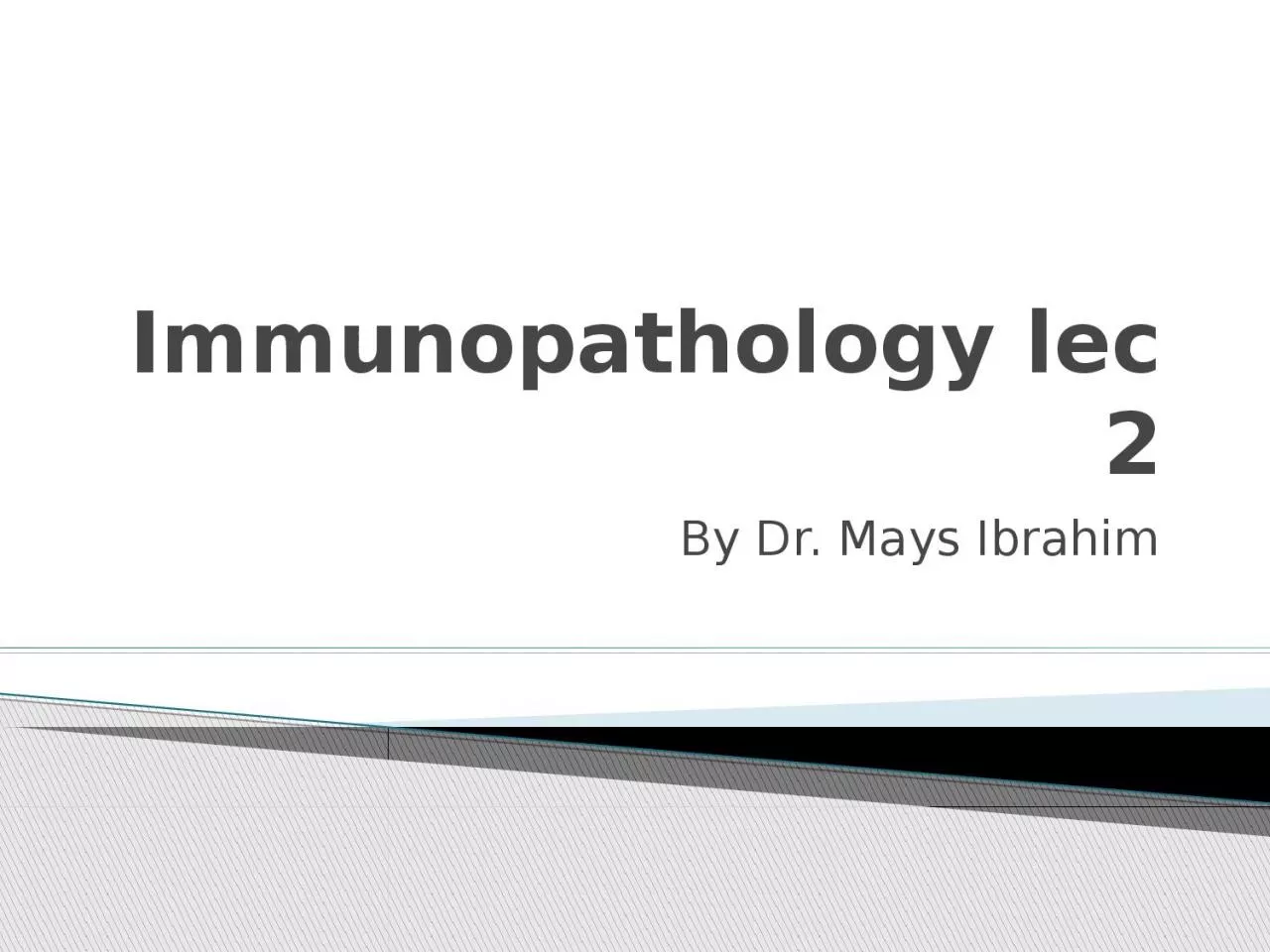

hypersensitivity type I hypersensitivity typre II hypersensitivity typre III hypersensitivity typre IV Types of hypersensitivity reactions Definition hypersensitivity reaction characterized by the formation of ID: 928797
Download Presentation The PPT/PDF document "Immunopathology lec 2 By Dr. Mays Ibra..." is the property of its rightful owner. Permission is granted to download and print the materials on this web site for personal, non-commercial use only, and to display it on your personal computer provided you do not modify the materials and that you retain all copyright notices contained in the materials. By downloading content from our website, you accept the terms of this agreement.
Slide1
Immunopathology lec 2
By Dr. Mays Ibrahim
Slide2hypersensitivity type Ihypersensitivity
typre
IIhypersensitivity typre IIIhypersensitivity typre IV
Types of hypersensitivity reactions
Slide3Definition:
hypersensitivity reaction characterized by the formation of
in-situ or circulating
antibody-antigen
immune complexes, which deposit in tissue resulting in complement activation, inflammation and tissue injury.Examples:Serum sicknessSystemic lupus erythematosus(SLE)Glomerulonephritis
Type III hypersensitivity (immune complex disease)
Slide4Slide5Definition
: hypersensitivity reaction mediated by sensitized T lymphocyte
Delayed type
hypersensitivity
CD4+ T-cell lymphocyte mediated granuloma formationCytotoxic T cell mediatedCD8+ T cell lymphocyte destroy antigen-containing cellsExamples
PPD
skin test and tuberculosis
Viral infections, immune reaction to tumors, contact dermatitis, type 1 diabetes
Type IV hypersensitivity (cell mediated type)
Slide6Slide7is
an immune reaction to self-antigens result from loss of self-tolerance.
Self-tolerance: is the normal state of non-responsiveness to one’s own antigens.
The
mechanisms of self-tolerance can be either central or peripheral:Central Tolerance:This refers to the process by which T and B cells that recognize self antigens are either killed (negative selection) or rendered harmless.
Negative selection: T cell expressing TCR with
high affinity
for self-antigens undergo apoptosis. This happens in the thymic medulla.
Peripheral Tolerance
Auto-reactive cells that
escape central regulatory
mechanisms can be removed or inactivated in the periphery through Anergy: is irreversible functional inactivation of T cells when they recognize self-antigen
Autoimmune disease:
Slide8Definition
: chronic systemic autoimmune disease characterized by loss of self tolerance and production of autoantibodies.
Epidemiology
:
Female more than maleAge 20-45Types of Autoantibodies present:
Antinuclear antibody(ANA) (more than 95%)
Anti-
dsDNA (40-60%)Anti-Sm(20-30%)
Mechanism
of injury:
type II and III hypersensitivity reactions
Cell injury (e.g., UV light and other environmental insults) leads to apoptosis and an increased burden of nuclear antigens. Defective B and T-cell tolerance leads to autoantibodies directed against the nuclear antigens, with the resulting immune complexes being ingested by B cells and dendritic cells; subsequent TLR engagement causes further cellular activation, cytokine production, and augmented autoantibody synthesis, which causes more apoptosis in a self-amplifying loop.
Autoimmune diseases:
Systemic lupus
erythematosus
(SLE):
Slide9hematologic
Hemolytic anemia
Thrombocytopenia
Neutropenia
LymphopeniaArthritis: polyarthralgia and synovitis without joint deformity.
Skin:
Malar “butterfly” rash, sunlight exacerbates the lesions
Maculopapular rashKidney diseases:
glomerulonephritis
Heart
Libman
sacks endocarditis(no bacterial endocarditis): numerous small, warty vegetations (1 to 3 mm) on the inflow or outflow surfaces (or both) of the mitral and tricuspid valvesSerosal
surfaces: pericarditis,
pleuritis, and pleural effusions
CNS: focal neurologic symptoms, seizure, and psychosis.
Treatment: steroid and immunosuppressive agents.Prognosis:Chronic unpredictable course with remission and relapse.Death is frequently due to renal failure and infectioins
Distribution of the disease:
Slide10Slide11Definition
: autoimmune disorder characterized by
destruction
of the lacrimal and salivary glands resulting
in inability to produce tears and saliva.Epidemiology:Female more than male age range 30-50
Clinical
features:
dry eyes-keratoconjunctivitis sicca
dry mouth-
xerostomia
mikulicz
syndrome: enlargement of the salivary and lacrimal glands often associated with rheumatoid arthritis and other autoimmune diseaseanti-ribonucleoprotein
antibodies
SS-A(Ro)
SS-B(La)
Complication: increased risk of developing lymphoma. Sjo"gren Syndrome
Slide12Definition
: autoimmune disease characterized by triad of autoimmunity, non-inflammatory
vasculopathy and collagen deposition with
fibrosis(fibroblast
stimulation and deposition of collagen in the skin and internal organs)Female more than maleAge range 20-55
Pathogenesis:
Vascular damage:
microvascular injury is the hallmark of the systemic sclerosis it is thought to be due to chronic perivascular fibrosis or by direct autoimmune attack. The end process of repeated injuries lead to vascular lumen narrowing. activation of fibroblast by cytokines, interleukin-1(IL-1), platelet derived growth factor(PDGF), and /or fibroblast growth factor(FGF) leads to fibrosis.
Scleroderma(progressive systemic sclerosis)
Slide13Advanced systemic sclerosis. The extensive subcutaneous fibrosis has virtually immobilized the fingers, creating a
clawlike
flexion deformity. Loss of blood supply has led to cutaneous ulcerations
Systemic sclerosis. A, Normal skin. B, Skin biopsy from a patient with systemic sclerosis. Note the extensive deposition of dense collagen in the dermis with virtual absence of appendages (e.g., hair follicles) and foci of inflammation (arrow).
Slide14IT IS OF TWO TYPES
Diffuse scleroderma
:
characterized by
Anti-DNA topoisomerase I antibodies(Scl-70) 70%Widespread skin involovement of Early involvement of visceral organsEsophagus-dysphagia
GI tract-
malabsorption
Pulmonary fibrosis-dyspnea on exertionCardiac fibrosis-arrythmias
Kidney fibrosis-renal insufficiency
Localized scleroderma
:
characterized byAnti-centromere antibodies
Limited Skin involvement of the face and hand
Late
involovement
of visceral organsRelatively benign clinical courseCan ssociate with -CREST syndrome: Calcinosis, Raynaud phenomenon, E
sophageal dysmotility, S
clerodatyly
,
T
elangiectasia
Slide15Is
a chronic autoimmune inflammatory disease that affects mainly the joints, especially small joints (digits before wrist, ankles, elbows, and knees) in a bilaterally symmetric pattern), but can affect multiple tissues (blood vessels, skin, heart, lungs, and muscles).
RA
is caused by an autoimmune response against self-antigen(s), which leads to T cell reactions in the joint with production of cytokines that activate phagocytes that damage tissues and stimulate proliferation of synovial cells (
synovitis). Antibodies may also contribute to the disease. About 80% of patients have serum immunoglobulin M (IgM) (and, less frequently, IgA) autoantibodies that bind to the Fc portions of their own (self )
IgG
.
These autoantibodies are called rheumatoid factor. They may form immune complexes with self-IgG that deposit in joints and other tissues, leading to inflammation and tissue damageRheumatoid arthritis (RA)